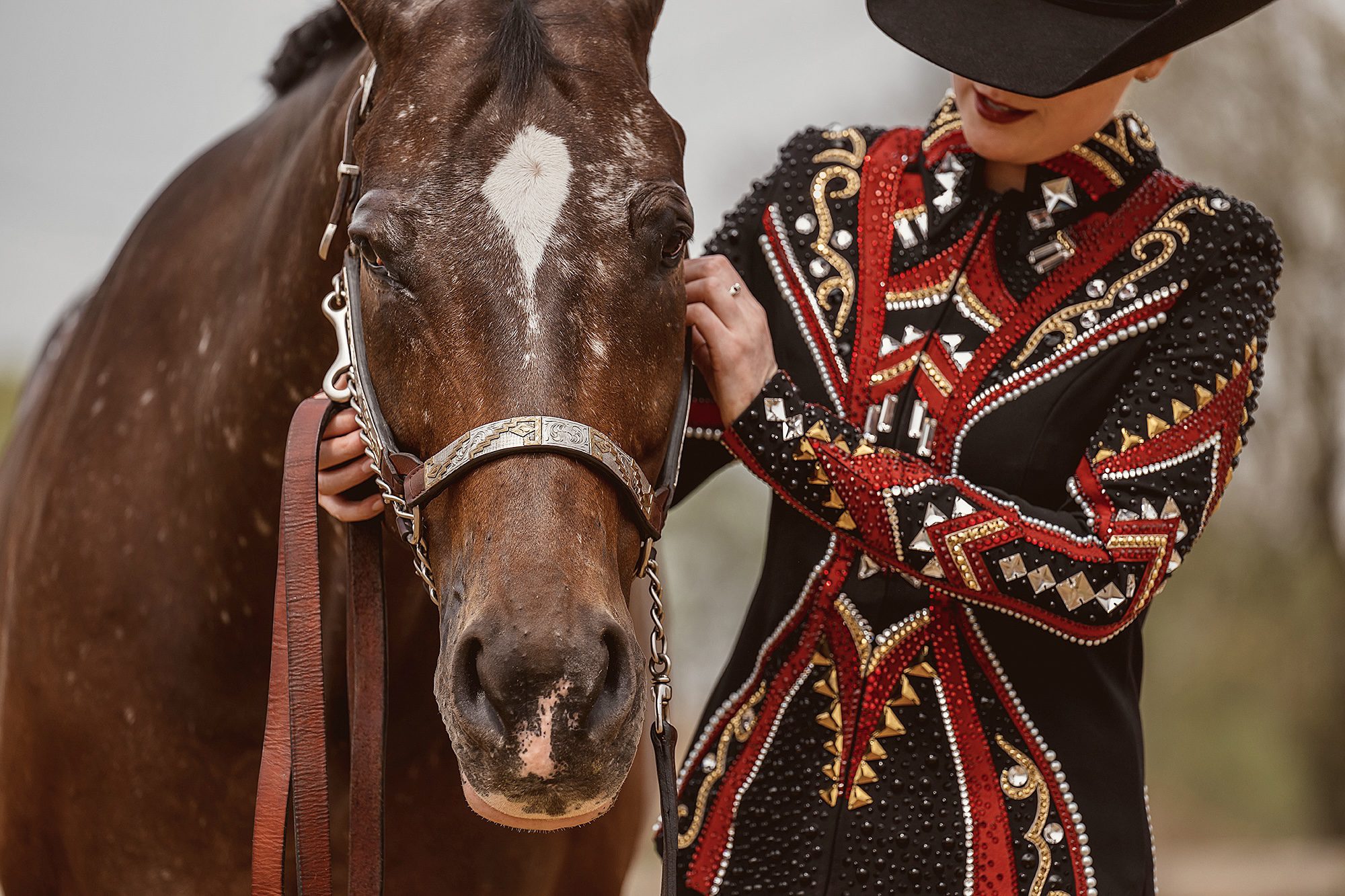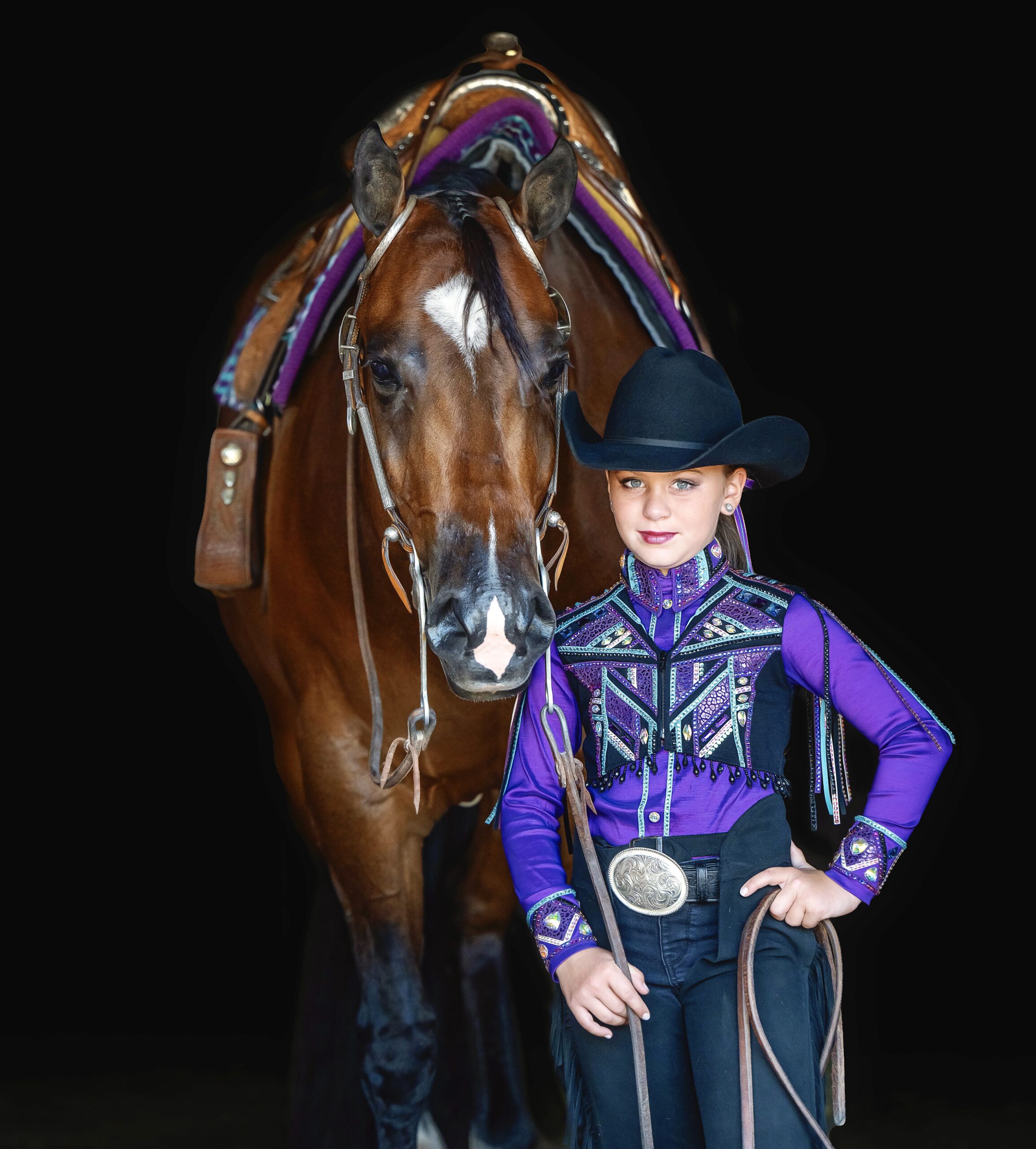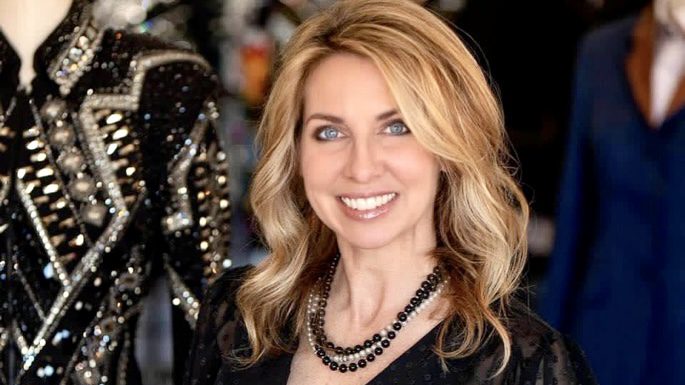We hear it all the time: how to choose show colors to match your horse – jewel tones for dark horses, earth tones for light horses, etc. However, the best “lewk” in the ring tends to be one whose colors and style are selected to show off the exhibitor as the primary consideration. Indeed, the horse isn’t wearing the outfit – you are! And in case you were wondering, a “lewk” in fashion is more than just a look, but a style unique to the person sporting it.
We spoke with leading horse show fashion expert Wendy Brown of Show Me Again to get her tips for dressing to highlight your own coloring and body-type in a way that compliments your horse and is fitting for your class.
Defining the Terms
Before we delve too deeply into how to dress for your skin, it is important to understand the terms commonly used by makeup artists and designers to describe skin – namely, what is the difference between your complexion and tone?
 In short, your complexion refers to the shade of your skin. A person’s complexion can be light, medium, or dark – and it can change depending on the time of year and sun exposure.
In short, your complexion refers to the shade of your skin. A person’s complexion can be light, medium, or dark – and it can change depending on the time of year and sun exposure.
Your skin tone or undertone, on the other hand, is consistent, even when your complexion changes. There are three types of undertones: warm (golden, yellow, or peachy), cool (pink, red, or blueish), and neutral (a mixture of warm and cool).
If you are unsure what your skin tone is, you should go to a makeup artist for their assessment. If you’re unable to do that, celebrity makeup artist Daniel Marton suggests you hold a piece of pure white paper up to your makeup-free face in natural lighting. If your skin looks rosy by comparison, you likely have a cool skin tone. If your skin looks more yellow, your undertone is likely warm. If you can’t decide, well, you’re likely a neutral.
Another hack used by Marton is to observe what happens to your skin when exposed to the sun. If you burn easily, your undertone is likely cool. If you tan easily, your undertone is likely warm. And if you burn and then tan, you likely have a neutral underdone.
Your skin complexion and tone can help you choose what colors are flattering on you, from your hair color to your clothing.
Dressing for Your Complexion
“My personal preference with darker skin complexions would be a bright or lighter tone to create a beautiful contrast and stand out. I love to see jewel tones on this skin type, such as purple, pink, peach, orange, yellow, jade green, or cobalt blue,” Brown explains.
 “I’ve found that lighter skin complexions look best in rich, deep colors such as dark brown, burgundy, grey, navy, bright and royal blue, amethyst, deep purples, lavender, lilac, sapphire, bright rose, ruby, and emerald green.” Brown further recommends light complexions, “stay away from pastels or whites so your face does not get washed out.”
“I’ve found that lighter skin complexions look best in rich, deep colors such as dark brown, burgundy, grey, navy, bright and royal blue, amethyst, deep purples, lavender, lilac, sapphire, bright rose, ruby, and emerald green.” Brown further recommends light complexions, “stay away from pastels or whites so your face does not get washed out.”
Brown has found that what looks most appealing on tan or medium complexions tends to be directly related to the individual’s undertone.
Therefore, a medium complexion with a cool undertone should follow the advice for a lighter complexion. A medium complexion with a warm undertone can follow the color advice for darker complexions. If you are a medium complexion with a neutral underdone, Brown recommends you “stay in neutral territory and avoid neon colors.”
Dressing for Your Body Type
While leaner, longer body types tend to get away with more intricate patterns and designs, those looking to lengthen their legs and slim their bodies down should follow the age-old adage that less tends to be more.
 Brown reminds readers, “We have many talented designers at our disposal in the equine industry who are making creations to slim and lengthen figures that are customized to the individual’s body type and preferences.”
Brown reminds readers, “We have many talented designers at our disposal in the equine industry who are making creations to slim and lengthen figures that are customized to the individual’s body type and preferences.”
If you’re not able to go the custom route, Brown advises that you look for “designs that tend to create a ‘V’ around the waistline and patterns that stay above the waistline with black or darker base.”
Another trick to lengthening your body is to shorten the waste to give the appearance of a longer leg. This is particularly evident in showmanship. “By shortening the overall length of a showmanship jacket, an exhibitor can create length in the lower body.”
Dressing for Your Division

What division you are competing in can make a big difference on what clothing will make the classiest statement.
One of the most exciting aspects of the youth classes is that you have a lot of freedom to play with fun, bright, and even wild colors. Brown exclaims, “You have the rest of your life to wear basic blacks and browns, so go for a color that makes you feel powerful and confident and wear it head to toe!”
When it comes to the amateur division, Brown believes there is a strong mental component to what riders feel comfortable in. “The sky really can be the limit for an amateur exhibitor, depending on what your strengths and goals are. I hear all the time from clients that they haven’t ‘earned’ the confidence to wear something bold,” Brown recounts.
“If you are still learning and want to gain some confidence, I would suggest going with something conservative, yet stylish. Alternatively, seasoned competitors that want to stand out should select something more bold and edgy.”
Finally, Brown believes “select riders should choose age–appropriate, tailored pieces. Remember, if the ‘trend’ does not suit your body type, I would not recommend following the trend.”
Dressing for Your Class

Brown reminds readers that an appreciation for the nature of the class and what the judges are looking for goes a long way. Riders have a lot more creative leeway in the western pleasure (and even in the hunter under saddle) than they do in the horsemanship or equitation.
Essentially, where the focus of the event is on the horse, fun design elements like fringe, sparkles, and bright colors help the duo stand out from the crowd.
However, where the focus is on the exhibitor, it is important to emphasize advantageous color blocking and clean lines while avoiding design elements that create added movement and distraction.
 If you’re unable to have different outfits for different classes, a good rule of thumb is to find something classic that fits well and doesn’t distract from the rider or the horse. Therefore, the more basic route tends to be less risky for all-day attire.
If you’re unable to have different outfits for different classes, a good rule of thumb is to find something classic that fits well and doesn’t distract from the rider or the horse. Therefore, the more basic route tends to be less risky for all-day attire.
***
Overall, Brown advises that exhibitors, “don’t forget about the small details in order to create an overall polished look. Pay attention to your makeup, hair, cleanliness, tack, and your horse. Your overall presentation should relay that you care a great deal about yourself and your show partner in the ring.”








